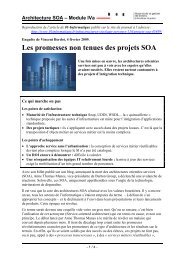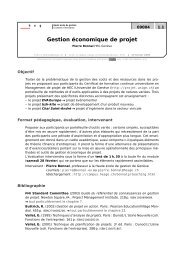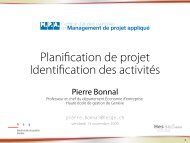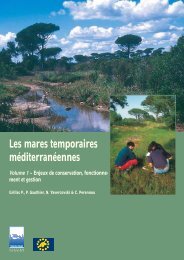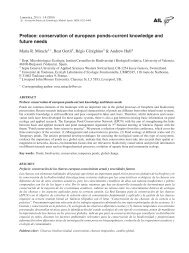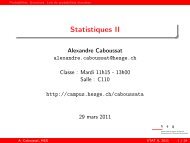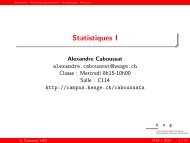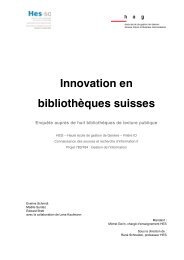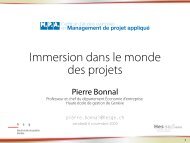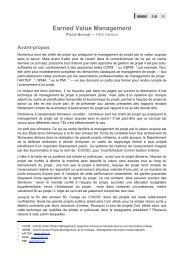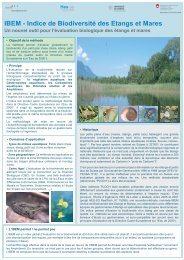see pdf document; 2 Mo
see pdf document; 2 Mo
see pdf document; 2 Mo
You also want an ePaper? Increase the reach of your titles
YUMPU automatically turns print PDFs into web optimized ePapers that Google loves.
TOMMELEN<br />
3<br />
SCARS OF WAR CONTAIN<br />
A SIGNIFICANT WILDLIFE RESOURCE
Letter of Support from the European Pond Conservation Network<br />
Ponds are small bodies of water which have characterised much of the European landscape for many<br />
centuries. Research has shown that they are a significant wildlife resource, very high when compared to other<br />
water bodies. However, the number of ponds continues to decline as a result of agricultural intensification<br />
and urban development and, during the twentieth century, as many as 90% have been lost in some countries,<br />
with most countries in western Europe recording a loss in excess of 50%. Apart from their wildlife value,<br />
ponds also need to be valued in terms of their historical origins and cultural value, as distinctive features of<br />
local landscapes, their visual attraction and the knowledge that they can help local people keep in touch with<br />
nature.<br />
The pond complex at Tommelen represents a unique landscape in which catastrophic events of 1944 gave<br />
birth to an area which has become a highly significant wildlife resource. Conservation of this area is highly<br />
significant, even at the European level. As such, every effort should be made to conserve the area, not only as<br />
an area of high wetland biodiversity, but also as a distinctive landscape which contains a valuable historic<br />
record for the citizens of Hasselt and for the allied airmen who took part in the bombing raids during the<br />
closing months of the Second World War.<br />
The European Pond Conservation Network (EPCN; http://www.europeanponds.org) was established in<br />
Geneva in 2004 and is a growing organization representing wetland and landscape scientists from<br />
universities, research organizations and conservation bodies from across the continent. The overall mission of<br />
the EPCN is to promote awareness, understanding and conservation of ponds in a changing European<br />
landscape and is therefore very pleased to support Natuurpunt and the City of Hasselt in any attempt to secure<br />
the long term future of this valuable site.<br />
Dr. Andrew Hull<br />
John <strong>Mo</strong>ores University<br />
Liverpool,<br />
United Kingdom<br />
Dr. Beat Oertli<br />
University of Applied<br />
Science of Western<br />
Switzerland,<br />
Switzerland<br />
Yours sincerely,<br />
Dr. Jeremy Biggs<br />
Ponds Conservation Trust,<br />
United Kingdom<br />
Dr. Régis Cereghino<br />
Université Paul Sabatier,<br />
France<br />
Dr. Patrick Grillas<br />
Tour du Valet,<br />
France
TABLE OF CONTENTS<br />
Intoduction.................................................................................................................................2<br />
Setting........................................................................................................................................3<br />
History of the area .....................................................................................................................4<br />
Current situation ........................................................................................................................7<br />
Ecological value ........................................................................................................................9<br />
Scientific value ........................................................................................................................11<br />
Perspectives .............................................................................................................................12<br />
References ...............................................................................................................................13<br />
Acknowledgments ...................................................................................................................14<br />
Annex I: Overview aerial bombardments................................................................................15<br />
Annex II: List of species..........................................................................................................16<br />
April 8th 1944<br />
Kruitwit stofschuim<br />
Iriserende stilte<br />
Lichtspoor van smart<br />
En smeulend verlangen naar<br />
Vrede<br />
(L. Vandenbosch)<br />
-1-<br />
© T. De Bie
Aerial photo of the<br />
marshalling yard in<br />
Hasselt taken from<br />
an American B-26,<br />
on 8 th April 1944<br />
INTRODUCTION<br />
European pond loss and its consequences for biodiversity are well <strong>document</strong>ed yet coherent<br />
pond conservation strategies remain elusive. A key to successful conservation is mobilising<br />
stakeholder interest. In many cases there is potential for integrating a site’s cultural-historical<br />
significance with its conservation importance to promote stakeholder awareness and<br />
conservation action. Many ponds are important historic features both in their own right, and<br />
as a result of their structure and sediments which may contain valuable information about the<br />
history of the site and the surrounding land. Ponds were created for a great diversity of<br />
agricultural and industrial purposes, particularly during the eighteenth and nineteenth<br />
centuries, and were a vital ingredient to local economies across the continent. They form an<br />
integral part in folk tale, myth and modern “urban” legend yet, all too often, historical and<br />
cultural association is often neglected 1 . Apart from agricultural and industrial uses, ponds<br />
have also been created as a result of other events. Of these, there are a number of cases where<br />
pond creation has occurred as result of large-scale destruction caused by bomb and shell<br />
craters associated with military operations. The pond complex at Tommelen in the province<br />
of Limburg in eastern Belgium provides one of the best remaining examples in Europe of this<br />
pond type which was created during the latter stages of the Second World War in 1944.<br />
-2-
Location of<br />
Tommelen, to the<br />
west of Hasselt<br />
Topographic map<br />
(scale 1/100.000 ,<br />
NGI, GIS-<br />
Vlaanderen, 1986-<br />
1990)<br />
SETTING<br />
The Tommelen pond complex is located on the western edge of the City of Hasselt in Belgian<br />
province of Limburg. As capital of the province, Hasselt has a population of 68,000 and is<br />
located 70 kilometres east of Brussels, in the Maas-Rhine region. The city is an important<br />
administrative centre as well as a commercial one.<br />
-3-<br />
U.K.<br />
FRANCE<br />
BELGIUM<br />
GERMANY
Aerial picture at<br />
the moment of<br />
impact. This<br />
picture was later<br />
used as<br />
propaganda<br />
material and<br />
dropped behind<br />
the German lines.<br />
HISTORY OF THE AREA<br />
During World War II more than two million bombs were dropped on Europe by the US<br />
alone 2 . In Belgium this caused up to 30,000 civilian fatalities, many more injuries and a<br />
significant impact on the social psyche. In preparation for D-Day, Europe’s rail network was<br />
targeted intensively. Belgium’s rail network was then the densest on earth (around 17km of<br />
track per 100 km², 58.3% of it multi-tracked 3 ). A key rail intersection and marshalling yards<br />
were located at Hasselt. Between 13.10 and 14.00, April 8th 1944, these were attacked by<br />
198 B-26 bombers, and 32 P-47 Fighter-bombers of the US 9th Army Air Force 4 . On April<br />
10th, 19th, 21st and on May 13th the station and the surrounding area were bombed again 5 .<br />
Civilians, railway infrastructure and buildings suffered most from the attacks on April 8th<br />
and 10th.<br />
“As a bombardier with the 575th Bomb Squadron, 391st Bomb Group, I participated in the<br />
April 8th 1944 attack at Hasselt. Our target was the marshalling yards. The bombs from the<br />
1st box landed in the target area, but the 2nd box missed badly. This was my 8th mission of<br />
70…”<br />
Richard Brooks, US 9 th Army Air Force, Rtd.<br />
-4-
HISTORY OF THE AREA<br />
The first formation on April 8th hit the target, destroying or seriously damaging 230 wagons<br />
and locomotives, damaging track and railway buildings 5 . Subsequent formations, hampered<br />
by smoke and dust, missed. Bombs fell on civilian areas, killing 56 people, wounding 40<br />
others and destroying 22 houses 6 . Many fell on pastureland around the marshalling yards.<br />
Also the subsequent air raid of April 10th took a heavy toll, especially in the direction of the<br />
city centre. Luckily most civilians were alert or already left the distressed area and fewer<br />
lives were lost in this attack.<br />
... I remember that day vividly. I lay on my back in the grass when the sirens went off. We did not<br />
know what was happening, because it was the first time we were bombed. ‘Gosh,’ I said, ‘All English<br />
planes that drop Easter eggs!’ We ran down the Beukenstraat on our clogs and saw some people<br />
hiding in the ditch. ‘Drop to the ground,’ they were yelling. At home, my mother was worried sick and I<br />
really caught it. – A. Feytons 6<br />
... We were just finishing the soup when the sirens of the railway company went off. Once outside, we<br />
saw different planes diving downwards. ‘This is not good, this is not good,’ our mother said and<br />
shortly afterwards we heard a hammering noise. As soon as possible we dove into the basement to<br />
find some shelter. … We knew that something was coming, because they warned us on the radio.<br />
We had an ‘American Bosh’, and always tried to reach an English radio station: ‘People, people of<br />
Western Europe, for the welfare of the war and for the progress of the liberation we have to bomb<br />
some specific targets. Watch out for factories, railway junctions and bridges.’ – Bonne 6<br />
...During many months the whole city slept in basements and bus shelters. Everybody was in fear<br />
and prayed constantly. The religious, half-religious and even the free-thinking, joined in. Our district<br />
was completely deserted. We also fled the city, but each week I returned to look after the vegetable<br />
garden, which was an important task at that time. The city was so quiet that it was a relief to hear the<br />
meow of some stray cats. – W. Greven 6<br />
...The moment I came across the railway, I heard: ‘wow wow wow.’ ‘Bombers!’ I thought, because I<br />
recognized the anti-aircraft guns. The level crossing keeper said he saw some parachutes in the<br />
distance, but it appeared to be bombs that were falling towards the marshalling yard of Kuringen.<br />
‘God Almighty,’ I said, ‘my parents inlaw live overthere’. I cycled as fast as possible in the direction of<br />
the inferno. From afar, a cloud of dust emerged and out of it came several people carrying others.<br />
<strong>Mo</strong>st of them wore German uniforms and crawled out of a train that was seriously hit . The front of<br />
the train pointed to the sky and from each side people jumped out. After a second strike, the house of<br />
my parents in-law was completely destroyed. It is difficult to describe what I witnessed that day. The<br />
only way I can express this event is by making a painting out of it, and I maybe will do this one day.<br />
– E. Borremans 6<br />
...This time it was even worse. Underneath, the ground was trembling while the machine-guns were<br />
rattling. Our bodies were shaking all over and the number of impacts were uncountable. The dismal<br />
howling of the airplanes was making me sick. I didn’t believe that there was somebody, no matter<br />
how strong he was, who could be immune to all this? All kind of questions entered my mind: ’Why do<br />
we have to endure this? We are being bombed by Americans and by the Englander, they are our<br />
allies, aren’t they?’ – J. Berx 7<br />
-5-
HISTORY OF THE AREA<br />
Between the 8th of April and 28th of May Hasselt was bombed fifteen times (Annex I). Five<br />
of these strikes were concentrated on the marshalling yard and its close surrounding. The<br />
consequences for the civilians were tragical. In Hasselt and Kuringen 107 civilians were<br />
killed and 144 got injured. Also the material damage was enormous: in total 454 houses were<br />
totally destroyed or heavily damaged and many more suffered a minor degree of damage.<br />
One of the commanders of these squadrons was Major Hair. He explained why these types of<br />
strikes were destructive on a relative large scale around the target. If a target of two hectares<br />
needed to be destroyed, than it was flown over by a formation that covered many more<br />
hectares. The moment the commander, who is always flying in the centre of the formation,<br />
spots the target he gives the order ‘release bombs’ to all planes simultaneous. The result is<br />
clear. <strong>Mo</strong>st likely, the target will be destroyed, but inevitable a lot of damage is done to the<br />
surrounding area.<br />
A complete assessment of the damage on the railway company and the surrounding<br />
workshops in Hasselt can still be retrieved in the files of the NMBS, the national railway<br />
company. The railway complex got 156 direct hits. <strong>Mo</strong>st of them (128) were concentrated on<br />
the depot of the locomotives and on the workshops of the wagons as well as on a German<br />
transport of troops that was standing still in the station, south of the workshops 8 . An overview<br />
of the different bombardments on the city of Hasselt is represented in Annex I.<br />
© T. De Bie<br />
© J. Mergeay<br />
-6-<br />
© M. Bex
Aerial view of the<br />
pond complex of<br />
Tommelen<br />
(January 2007)<br />
CURRENT SITUATION<br />
Over time, the majority of the bomb craters filled in. Nevertheless, more than 110 were<br />
preserved, forming permanent or seasonal ponds and creating a diverse and unique wetland<br />
habitat. The site’s 110 ponds lie within an area of 11.86 ha (i.e. around 10 ponds/ha). The<br />
main vegetation is species rich, rough grassland (7.58 ha), of which 0.67 ha is planted with<br />
more than seventy standard trees bearing old fruit varieties. The remaining area of 4.28 ha<br />
consists of woodland with willow, birch, oak and till recently with a poplar plantation.<br />
Aiming for an improvement of the water management of the area, the poplar trees were<br />
recently removed and by doing so, also a number of large ponds could be restored. To<br />
minimize the disturbance from the railway and surrounding roads, a buffer of indigenous<br />
trees will be planted. At the moment, the management consists of dredging of the ponds and<br />
of annual grazing by Galloway cattle and mowing to prevent forestation and natural<br />
succession. The central part of the pond complex is only accessible by guided tours.<br />
The land is owned by the City of Hasselt and was leased as pasture to farmers until 1995.<br />
From 1996 it was managed by Wielewaal. This nature conservation organization merged<br />
with Natuurreservaten under the name Natuurpunt, who are currently the leading nature<br />
conservation organization in Flanders in the field of nature conservation at the moment. The<br />
current lease agreement comes to an end in 2016.<br />
In the beginning of the nineties, proposals surfaced for industrial development. A united<br />
action programme of local residents and members of ‘Groencomité Hasselt’ ensured a<br />
prolonged conservation of the area, but was not able to obtain an official designation for the<br />
-7-<br />
© T. De Bie
CURRENT SITUATION<br />
site as nature reserve. In 2004, new plans arose for a further expansion of the residential<br />
zone, including a part of the area. On the long term, this would destroy the ecological value<br />
of the area. Currently, this proposal has been countered after heavy protest by ‘Natuurpunt’<br />
and ‘Groencomité Hasselt’. An application for a designation as an official nature reserve was<br />
submitted in July 2006. The main objective is to optimize Tommelen as a hot spot for<br />
amphibians with, in the core area, a half open landscape in which the conservation of ponds<br />
and woody edges is central. In the northwestern and western areas a closed landscape is<br />
targeted, where woodlands and scrub can develop. In the application, both the ecological<br />
value and the historical importance are included. Contacts with associations of American<br />
veterans (like artillery man Richard Brooks and lieutenant-colonel ‘Wally’ <strong>Mo</strong>rgan, who led<br />
the bomb squadron on the 8 th of April 1944) and with local people who witnessed the<br />
bombing can help to convince the citizens of Hasselt of the historical and cultural importance<br />
of this area. All the more, since a number of interviewees from Hasselt and the surrounding<br />
area were still strongly and emotionally affected by the memories of these tragic events.<br />
-8-<br />
© T. De Bie
ECOLOGICAL VALUE<br />
The pond complex and the surrounding terrestrial biotopes have a high capacity to support a<br />
wide range of organisms, many of high conservation importance, particularly amphibians and<br />
macro-invertebrates. Large populations of six species of amphibians are still present in the<br />
fishless ponds: Rana esculenta synklepton, Rana temporaria, Bufo bufo, Triturus alpestris,<br />
Triturus cristatus and Triturus vulgaris. Tommelen is located at the geographical border of<br />
De Kempen and Vochtig Haspengouw. This also explains the uncommon combination of<br />
three newt species at the same location.<br />
© M. Bex<br />
© M. Bex<br />
© M. Bex<br />
The Great Crested Newt is a European protected species which falls under the<br />
Habitat Directive and for whose preservation the allocation of special protected<br />
areas is required. The range of the species extends from Great Britain in the west<br />
across much of Europe north of the Alps and the Black Sea. Although the great<br />
crested newt can still be found in most provinces of Belgium, the distribution is<br />
fragmented and the potential habitat is reducing at a very high speed 9 . Because<br />
of the high density of ponds and their structural heterogeneity, Tommelen<br />
provides ideal conditions for the reproduction of the species. Therefore it is not<br />
surprising that this area houses the largest population of great crested newts in<br />
Flanders.<br />
On European scale, populations of great crested newts, and amphibians in<br />
general, strongly declined during the last decades due to the degradation and<br />
reduction of their habitat (e.g. drainage and dropping groundwater levels).<br />
Increased land development pressure from population growth, agricultural<br />
intensification and expansion and even climate change 10 impose a serious threat<br />
to the survival of amphibians. To put a stop to the decline of amphibians and to<br />
ensure the prolonged existence of the great crested newt, there is need for a well-<br />
considered management strategy that protects the remaining pond landscapes<br />
(both ponds and the surrounding land) and creates additional ponds which are<br />
strategically located.<br />
-9-<br />
© D. Ercken
ECOLOGICAL VALUE<br />
Despite the common history of the ponds, being created almost simultaneously, there is<br />
striking diversity in pond characteristics. Pond surface area and depth vary with the bomb<br />
size and overlapping craters. Crater depth is important in determining hydro-period - larger<br />
bombs created deeper craters, penetrating into the underlying clay - hence more permanent<br />
ponds. Smaller craters do not extend so far into the sub-soil and are more ephemeral in<br />
nature, so both permanent and temporary ponds were created.<br />
The combination of both types of ponds nestled in natural grassland provides ideal conditions<br />
for dragon- and damselflies. A partial inventory has already revealed 13 species, which<br />
included the rare and threatened Brown Emerald Damselfly and the Emperor Dragonfly. Also<br />
butterflies like the Common Blue, the Holly Blue, the Hedge Brown and the Small Skipper<br />
are omnipresent.<br />
Despite the fact that all ponds are located in the same meadow and have a similar age, there<br />
is still a wide variation in pH, conductivity, nutrient status, shading and litter input 11 . Field<br />
observations also indicate large dissimilarities in vegetation cover, with ponds displaying<br />
diverse and abundant submerged, floating, emergent and marginal vegetation in close<br />
proximity to sparsely vegetated ponds. In the entire area, more than 200 plant species are<br />
recorded (<strong>see</strong> appendix II). Some important species are: Broad-Leaved Pond Weed,<br />
Bladderwort, Water Starwort and Marsh St. Johns-wort. The marginal vegetation is mainly<br />
dominated by Soft Rush, but also Common Clubrush, Arrowhead and Unbranched Burr-reed<br />
occurred. The hedges, woody edges and forest in combination with the open grassland offer a<br />
suitable nesting and foraging place to a number of birds. Especially small songbirds, like the<br />
Meadow Pipit, Reed Bunting and the Nightingale occur in the site.<br />
© J. Mergeay<br />
© M. Bex<br />
-10-<br />
© T. De Bie
Aerial picture of<br />
the pond complex<br />
before the poplar<br />
plantation was<br />
cleared.<br />
SCIENTIFIC VALUE<br />
The high density of ponds (high number on a small scale) in Tommelen is quite exceptional<br />
in Belgium. The fact that all ponds have a similar origin and are situated in the same<br />
geographical context (soil type and ground quality) provides unique opportunities for<br />
fundamental and applied ecological research. That is why the pond complex, as a study area,<br />
will play an important role in a recently approved research project PONDSCAPE, a project<br />
sponsored by the Belgian Science Policy (2007-2011). One of the objectives of this project is<br />
to obtain insights into the factors that determine the differences in biodiversity among ponds<br />
and to investigate the main drivers that shape pond communities. This is especially relevant<br />
in an effort to test how total diversity within a pond complex can be increased by applying<br />
standard management techniques.<br />
THREATS<br />
Tommelen is strongly isolated. The site is sandwiched by the city on the western side, the<br />
E313 roadway, the N2 and the Hasselt ring road. Another significant barrier to dispersal is<br />
the railway and marshalling yards of the railway station. On a long term this isolation can<br />
seriously threaten species richness and ecological value of the site. Colonization of<br />
amphibians and other organisms is severely hampered and may not compensate for<br />
occasional stochastic extinctions. Further planned research should indicate to what extent<br />
isolation has already affected local communities and in time, the degree of connectivity with<br />
the low-lying grassland and ponds at the other side of the highway should be improved.<br />
-11-<br />
© J. Coteur
PERSPECTIVES<br />
A number of undermetioned proposals relate to the complete pond complex, others are<br />
restricted to the land which was recently cleared of poplars. Access to the main body of the<br />
site and pond complex will be restricted as at present.<br />
o Dedicated and designated nature conservation and heritage site<br />
o Restoration of degraded ponds<br />
o Improvement of the connectivity of the pond complex with Herkenrodebos and the<br />
expected city forest at the other side of the E313 highway, western of Tommelen.<br />
o Improve the access to the site and parking where appropriate.<br />
o Create a small environmental education centre, guided nature trail including pond<br />
creation and interpretation and erect a covered interpretation panel as a memorial to<br />
the events of 1944<br />
o Prepare a teacher resource pack<br />
o Healing/celebration/memorial sculpture<br />
o Planting of ‘a Forest of Peace’ in the meadow close to the orchard by the Flemish<br />
Forestry Organization.<br />
o Create a spotters tower<br />
All the above proposals are dependent on available funding.<br />
© J. Mergeay<br />
© T. De Bie<br />
© M. Bex<br />
-12-
REFERENCES<br />
(1) Boothby, J. (1998) Ponds, a search for significance. In: Boothby, J. (Ed.) Ponds and pond<br />
landscapes of Europe: Proceedings of the International Conference of the Pond Life Project,<br />
Maastricht, The Pond Life Project, UK.<br />
(2) United States Army Airforces statictical sigest, World War II. (1945) Number of bombs<br />
dropped overseas, 1943 to 1945, Table 137. http://www.usaaf.net/digest/t137.htm.<br />
(3) United States Army Air Forces. (1944) We’re attacking the heaviest rail concentration on<br />
earth. Impact. Office of the Assistant Chief of Air Staff, Intelligence, Washington DC.<br />
(4) United States Army Air Forces Combat Chronology. (1944)<br />
http://www.usaaf.net/chron/44/apr44.htm.<br />
(5) Stadsarchief van Hasselt (1944) Beknopt overzicht van de luchtbombardementen tusschen<br />
8 april en 28 mei 1944. Verslag nr. 547.91.<br />
(6) Getuigenis afgenomen door Karin De Greeve voor Erfgoedcel Hasselt (2006).<br />
(7) Berx J. (1944) Herinneringen ’40-’44: De eerste oorlogsdagen, bommen op Kuringen en<br />
Hasselt tijdens de eerste dagen der bevrijding door de geallieerden.<br />
(8) Sterken L. (1977) Toen kwam Hasselt aan de beurt. In: Oude dossiers weer open. Het<br />
Belang van Limburg 5 april 1977.<br />
(9) Schops, I. (1999) Amfibieën en reptielen in Limburg: verspreiding, bescherming en<br />
herkenning. LIKONA, Genk, p. 51.<br />
(10) Carey C. and M.A. Alexander (2003) Climate change and amphibian declines: is there a<br />
link? Diversity and distribution 9: 111-121.<br />
(11) Poorters N. (2002) Invloed van de omgevingsfactoren op de aan- of afwezigheid van<br />
amfibieën. Case Study: poelengebied Tommelen. Master’s thesis, Katholieke Hogeschool<br />
Limburg.<br />
-13-
ACKNOWLEGEMENT<br />
The realisation of this <strong>document</strong> was made possible by the support of the European Pond<br />
Conservation Network (EPCN), Natuurpunt Hasselt-Zonhoven, Erfgoedcel Hasselt, Stad<br />
Hasselt, H. Reynders (mayor), M. Froidmont (councilman of environmental issues), L. Pollet<br />
(councilman of the patrimoniale estate), De Limburgse Koepel voor Natuurstudie (LIKONA),<br />
Groencomité Hasselt and the members of the Tommelen working group. We would like to<br />
thank all witnessess for their co-operation and J. Hollinshead and K. De Greeve for taking the<br />
interviews. Scientific support was delivered by the Laboratory of Aquatic Ecology &<br />
Evolutionary Biology of K.U.Leuven, the amphibian and reptile study group of Natuurpunt<br />
(HYLA) and the Royal Belgian Institute of Natural Scienses (RBINS). The authors have tried<br />
to <strong>document</strong> everything as precise as possible and are not responsible for errors or<br />
incompletenesses.<br />
© T. De Bie<br />
-14-<br />
European Pond Conservation Network:<br />
http://www.europeanponds.org<br />
Natuurpunt Hasselt-Zonhoven:<br />
www.natuurpunthasseltzonhoven.be<br />
Erfgoedcel Hasselt:<br />
www.erfgoedcelhasselt.be<br />
Laboratory of Aquatic Ecology &<br />
Evolutionary Biology (K.U.Leuven):<br />
bio.kuleuven.be/eco<br />
Hyla: amphibian & reptile study group:<br />
www.hylawerkgroep.be<br />
Limburgse Koepel voor natuurstudie:<br />
www.limburg.be/likona<br />
Royal Belgian Institute for Natural Sciences<br />
(RBINS): www.natuurwetenschappen.be<br />
De stad Hasselt:<br />
www.hasselt.be<br />
The Flemish Governement:<br />
http://start.vlaanderen.be
APPENDIX I: OVERVIEW AERIAL BOMBARDMENTS<br />
From the archives of the city of Hasselt, excerpt from report no. 547.91:<br />
A concise overview of the air raids between April 8th and May 28th 1944.<br />
1 st Bombardment: 8 April, 13.15, 13.50 and 14. The first strike was carried out by<br />
about 75 heavy bombers who flew over the city of Hasselt at an altitude of<br />
approximately 2000 meters. They dropped their bomb load on our territory on stretch<br />
of more than 150 ha and especially on the district of Kuringen and Runxter, in the<br />
close surrounding of the marshalling yards. Buildings situated more than 600 meters<br />
away from the target were hit.<br />
2 th bombardment: 10 April, 10.45. This bombardment was carried out by two<br />
subsequent waves of bombers. They flew over our territory in western direction and<br />
dropped their bomb load on the west side of the side of the city, nevertheless also some<br />
bombs were dropped in the Issebellastraat in the city centre.<br />
3 th bombardment: 19 April, 15. 30. Air attack on the marshalling yards with a light<br />
formation of fighter-bombers.<br />
4 th bombardment: 21 April, 10.30. This bombardment was the same as the previous<br />
one.<br />
5 eth bombardment: 11 May 23.50. Northeastwards of the city centre. <strong>Mo</strong>st severe<br />
bombardment up to now after a dogfight above Hasselt.<br />
6 th and 7 th bombardment: 12 May, 10.45 and 17.20. Region of Kuringen, attack on<br />
the bridge of the railway across the Albertkanaal.<br />
8 th bombardment: 13 May, 0.38, Hundreds of bombs fell southwards of the<br />
marshalling yards in the farmlands around the buildings in the Tommelen- and<br />
Jodenstraat, in the neighbourhood of the Pietelbeekstraat and the railway Hasselt-<br />
Landen.<br />
9 th and 10 th bombardment: 22 May, 15.15 and 18.07. Attack on the railway-bridge<br />
across the Albertkanaal<br />
11 th and 12 th bombardment: 23 May, 15. 30 and 17. 05. The same target.<br />
13 th bombardment: 25 May, 11.07. The same target.<br />
14 th and 15 th bombardment: 28 May, 10.00 and 16.40. The same target.<br />
-15-<br />
© T. De Bie
APPENDIX II: LIST OF SPECIES<br />
BUTTERFLIES BIRDS<br />
Anglais urticae Small Tortoiseshell Accipiter nisus Sparrowhawk<br />
Anthocharis cardamines Orangetip Aegithalos caudatus Long-tailed Tit<br />
Aphantopus hyperantus Ringlet Anas platyrhynchos Mallard<br />
Celastrina argiolus Holly Blue Anthus pratensis Meadow Pipit<br />
Colias hyale Pale clouded Yellow Buteo buteo Buzzard<br />
Lycaena phlaeas Small Copper Certhia brachydactyla Short Toed Treecreeper<br />
Maniola jurtina Meadow Brown<br />
Chloris chloris<br />
Green Finch (Carduelis<br />
chloris)<br />
Papilio machaon Swallowtail Columba palumbus Wood Pigeon<br />
Pieris brassicae Large White Corvus corone Carrion Crow<br />
Pieris napi Green-veined White Cuculus canorus Cuckoo<br />
Pieris rapae Small White<br />
Drendocopos major<br />
Greater Spotted<br />
-16-<br />
Woodpecker<br />
Polygonia c-album Comma<br />
Drendocopos minor<br />
Lesser Spotted<br />
Woodpecker<br />
Polyommatus icarus Common Blue Emberiza schoeniclus Reed Bunting<br />
Pyronia tithonus Hedge Brown Erithacus rubecula Robin<br />
Thymelicus sylvestris Small Skipper Falco Tinnunculus Kestrel<br />
Vanessa atalanta Red Admiral Fringilla coelebs Chaffinch<br />
Vanessa cardui Painted Lady Gallinulla chloropus <strong>Mo</strong>orhen<br />
Garrulus glandarius Jay<br />
AMPHIBIANS Luscinia megarhynchos Nightingale<br />
Bufo bufo Common Toad <strong>Mo</strong>tacilla flava Yellow Wagtail<br />
Pelophylax esculenta Edible Frog, Green Frog Parus caeruleus Blue Tit<br />
Pelophylax lessonae Pool Frog Parus major Great Tit<br />
Rana temporaria Common Frog Parus montanus Willow Tit<br />
Triturus alpestris Alpine Newt Phasianus colchicus Pheasant<br />
Triturus cristatus Great Crested Newt Phylloscopus collybita ChiffChaff<br />
Triturus vulgaris Smooth Newt Phylloscopus trochilus Willow Warbler<br />
Pica pica Magpie<br />
ODONATES Picus viridis Green Woodpecker<br />
Aeshna cyanea Southern Hawker Prunella modularis Dunnock<br />
Anax imperator Emperor Dragonfly Streptopelia turtur Turtle Dove<br />
Coenagrion puella Azure Damselfly Streptopelia decaocto Collared Dove<br />
Enallagma cyathigerum<br />
Common Blue<br />
Sturnus vulgaris Starling<br />
Damselfly<br />
Ischnura elegans Blue-tailed Damselfly Sylvia atricapilla Black Cap<br />
Lestes barbarus Shy Emerald Damselfly Sylvia borin Garden Warbler<br />
Lestes sponsa Emerald Damselfly Sylvia communis Whitethroat<br />
Lestes viridis<br />
Green Emerald<br />
Damselfly<br />
Troglodytes troglodytes Wren<br />
Libellula depressa Broad bodied Chaser Turdus merula Black Bird<br />
Pyrrhosoma nymphula Large Red Damselfly Turdus philomelos Song Thrush<br />
Sympecma fusca<br />
Brown Emerald<br />
Turdus viscivorus Mistle Thrush<br />
Damselfly<br />
Sympetrum flaveolum Yellow-winged Darter D. Vanellus vanellus Lapwing<br />
Sympetrum sanguineum Ruddy Darter D.<br />
© J. Mergeay
APPENDIX II: LIST OF SPECIES<br />
PLANTS PLANTS<br />
(groep) Phleum pratense Timothy Grass Dactylis glomerata Cocksfoot<br />
(groep) Rosa canina Dog Rose Daucus carota Wild Carrot<br />
Acer campestre Sorrel Dryopteris carthusiana Narrow Buckler Fern<br />
Achillea millefolium Yarrow Dryopteris filix-mas Male Fern<br />
Achillea ptarmica Sneezewort Eleocharis palustris s.s. Common Spike-rush<br />
Aegopodium podagraria Ground Elder Elymus repens Couch Grass<br />
Agrostis capillaris Common Bent Epilbium angustifolium Rosebay Willowherb<br />
Alisma plantago-aquatica Common Water-Plantain Epilobium hirsutum Great Willowherb<br />
Alliaria petiolata Garlic Mustard<br />
Epilobium tetragonum<br />
Square-Stalked<br />
Willowherb<br />
Alnus glutinosa Alder Epipactis helleborine Broad-Leaved helliborine<br />
Alopecurus aequalis Shortawn Foxtail (US). Equisetum arvense Common Horsetail<br />
Alopecurus geniculatus Marsh Fox-tail Equisetum fluviatile Water Horsetail<br />
Alopecurus pratensis Meadow Fox-tail Erophila verna Common Whitlow Grass<br />
Anemone nemorosa Wood Anemone Eupatorium cannabinum Hemp-Agrimony<br />
Angelica sylvestris Angelica Festuca pratensis Meadow Fescue<br />
Anthoxanthum odoratum Sweet Vernal-grass Filipendula ulmaria Meadowsweet<br />
Anthriscus sylvestris Cow Parsley Frangula alnus Alder Buckthorn<br />
Apera spica-venti<br />
Loos Silky-bent, Wind<br />
Fraxinus excelsior Ash<br />
Grass<br />
Arrhenatherum elatius False Oat-grass Galeopsis tetrahit Common Hemp-Nettle<br />
Artemisia vulgaris Mugwort Galium aparine Cleavers or Goose Grass<br />
Baldellia ranunculoides<br />
Lesser Water-Plantain Galium mollugo Hedge Bedstraw<br />
ssp. repens<br />
Bellis perennis Daisy Galium palustre Marsh Bedstraw<br />
Betula pendula Silver Birch Geranium robertianum Herb Robert<br />
Bidens frondosa Devil's Beggartick (US) Glechoma hederacea Ground Ivy<br />
Bidens tripartita Trifid Burr-Marigold Glyceria fluitans Floating Sweet-grass<br />
Callitriche hamulata Water Starwort (group) Gnaphalium uliginosum Marsh Cudweed<br />
Callitriche spec. Water Starwort (group) Hedera helix Ivy<br />
Caltha palustris Marsh Marigold Heracleum sphondylium Hogweed<br />
Calystegia sepium Hedge Bindweed Hieracium pilosella <strong>Mo</strong>use-ear Hawkweed<br />
Capsella bursa-pastoris Shepherds Purse Hieracium sabaudum New England Hawkweed<br />
Cardamine flexuosa Wavy Bittercress Hieracium umbellatum Leafy Hawkweed<br />
Cardamine pratensis Ladies Smock Holcus lanatus Yorkshire Fog<br />
Carex acuta Slender Tufted Sedge Hottonia palustris Water Violet<br />
Carex acutiformis Lesser Pond Sedge<br />
Hydrocharis morsus-<br />
Frogbit<br />
ranae<br />
Carex disticha Brown Sedge Hydrocotyle vulgaris Pennywort<br />
Carex hirta Hairy Sedge Hypericum elodes Marsh St. Johns-wort<br />
Carex ovalis Oval Sedge Hypericum perforatum Perforate St. Johns-wort<br />
Carex vesicaria Bladder Sedge Hypochaeris radicata Common Cats-Ear<br />
Carpinus betulus Hornbeam Ilex aquifolium Holly<br />
Castanea sativa Sweet Chestnut Iris pseudacorus Yellow Iris<br />
Centaurea thuillieri Meadow Knapweed Juncus acutiflorus Sharp-flowered Rush<br />
Cerastium fontanum Common <strong>Mo</strong>use-Ear Juncus articulatus Jointed Rush<br />
Chaerophyllum temulum Rough Chervil Juncus bufonius s.s. Toad Rush<br />
Chelidonium majus Greater Celandine Juncus conglomeratus Compact Rush<br />
Cirsium arvense Creeping Thistle Juncus effusus Soft Rush<br />
Cirsium palustre Marsh Thistle<br />
Juncus tenuis<br />
Wiry, Path or Poverty<br />
Rush (US)<br />
Cirsium vulgare Spear Thistle Lactuca serriola Prickly Lettuce<br />
Convolvulus arvensis Common Bind Weed Lamium album White Dead-nettle<br />
Conyza canadensis Canadian Fleabane Lamium galeobdolon Yellow Archangel<br />
Corylus avellana Hazel Lamium purpureum Red Dead-nettle<br />
Crataegus monogyna Hawthorn Lapsana communis Nipplewort<br />
Cynosurus cristatus Crested Dog's-tail Lemna minuta Least Dickweed<br />
Cytisus scoparius Broom Leontodon autumnalis Autumn Hawkbit<br />
-17-
APPENDIX II: LIST OF SPECIES<br />
PLANTS PLANTS<br />
Leucanthemum vulgare Oxeye Daisy Ranunculus sceleratus Celery-Leaved Buttercup<br />
Linaria vulgaris Common Toadflax Ribes rubrum Red Currant<br />
Lolium perenne Perennial Rye-grass Robinia pseudoacacia False Acacia<br />
Lonicera periclymenum Honeysuckle, Woodbine Rorippa amphibia Great Yellow-cress<br />
Lotus pedunculatus Greater Birds-foot-trefoil Rorippa palustris Marsh Yellow-cress<br />
Ludwigia grandiflora<br />
Largeflower primrose<br />
Rubus spec. Bramble spec.<br />
willow (US)<br />
Luzula multiflora Heath Woodrush Rumex acetosa Common Sorrel<br />
Lychnis flos-cuculi Ragged Robin Rumex acetosella Sheep’s Sorrel<br />
Lycopus europaeus Wolfs Bane Rumex crispus Curled Dock<br />
Lysimachia vulgaris Yellow Loosestrife Rumex obtusifolius Broad-leaved Dock<br />
Lythrum portula Water-purslane Sagina apetala Annual Pearlwort<br />
Lythrum salicaria Purple-loosestrife Sagittaria sagittifolia Arrowhead<br />
Matricaria recutita Scented Mayweed Salix alba White Willow<br />
Medicago lupulina Black medic Salix x multinervis Willow and Salow<br />
Mentha aquatica Watermint Sambucus nigra Elder<br />
Myosotis arvensis Field Forget-me-not Saxifraga tridactylites Rue-leaved Saxifrage<br />
Myosotis cespitosa Tufted Forget-me-not Scirpus lacustris Common Clubrush<br />
Papaver dubium Long-headed Poppy Scrophularia nodosa Common Figwort<br />
Phalaris arundinacea Common Reed Grass Senecio jacobaea Common Ragwort<br />
Phragmites australis Common Reed Silene dioica Red Campion<br />
Plantago lanceolata Ribwort Plantain Solanum dulcamara Bittersweet<br />
Plantago major Greater Plantain Sonchus asper Prickly Sow-Thistle<br />
Poa annua Annual Meadow-grass Sorbus aucuparia <strong>Mo</strong>untain Ash<br />
Poa trivialis Rough Meadow-grass Sparganium emersum Unbranched Burr-reed<br />
Polygonum amphibium Amphibious Bistort Sparganium erectum Branched Burr-Reed<br />
Polygonum aviculare Knotgrass Spergula arvensis Corn Spurrey<br />
Polygonum hydropiper Waterpepper Stachys sylvatica Hedge Woundwort<br />
Polygonum lapathifolium Pale Persicaria Stellaria alsine Bog Stitchwort<br />
Polygonum persicaria Red-shank Stellaria graminea Lesser Stitchwort<br />
Populus canadensis Canadian Poplar Stellaria holostea Greater Stitchwort<br />
Populus canescens Grey Poplar Stellaria media Common Chickweed<br />
Populus tremula Aspen Symphytum officinale Common Comfrey<br />
Potamogeton natans<br />
Broad-Leaved Pond<br />
Tanacetum vulgare Tansy<br />
Weed<br />
Potentilla anserina Silver weed Taraxacum, spec. Dandelion spec.<br />
Potentilla erecta Tormentil Trifolium pratense Red Clover<br />
Primula elatior Cowslip Trifolium repens White Clover<br />
Prunella vulgaris Self-Heal Tussilago farfara Colt’s-Foot<br />
Prunus avium Bird Cherry Typha latifolia Bulrush<br />
Prunus serotina Rum Cherry Urtica dioica Stinging Nettle<br />
Prunus spinosa Blackthorn Utricularia australis Bladderwort (U. neglecta)<br />
Pteridium aquilinum Bracken Valeriana repens Valerian (V. officinalis)<br />
Pulicaria dysenterica Common Fleabane Veronica arvensis Wall Speedwell<br />
Quercus robur Sessile Oak Viburnum opulus Guelder Rose<br />
Quercus rubra Red Oak Vicia cracca Tufted Vetch<br />
Ranunclus spec. Buttercup Spec. Vicia hirsuta Hairy Tare<br />
Ranunculus acris Meadow Buttercup Vicia sativa ssp. sativa Common Vetch<br />
Ranunculus ficaria Lesser Celandine Vicia sepium Bush Vetch<br />
Ranunculus flammula Lesser Spearwort Vicia tetrasperma Smooth tare<br />
Ranunculus repens Creeping Buttercup Viola tricolor Wild Pansy<br />
-18-
This brochure was assembled by<br />
The Tommelen-working group<br />
With contributions of<br />
Tom De Bie<br />
Jim Hollinshead<br />
Rik Jacobs<br />
Steven Declerck<br />
Jos Coteur<br />
Paul Vos<br />
Luc Vandenbosch<br />
Tinne Rock<br />
Hanne Indekeu<br />
Sabine Hartmann<br />
Peter Engelen<br />
Boudewijn Goddeeris<br />
Andrew Hull<br />
Coordination and graphic design<br />
Tom De Bie<br />
Contact<br />
Natuurpunt Hasselt-Zonhoven<br />
info@natuurpunthasseltzonhoven.be<br />
Fragments of the text may be copied if the source is quoted.<br />
Printed in 2008<br />
-19-



